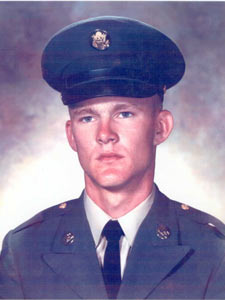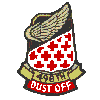13 Feb 2004
DUSTOFF IS ON FIRE!!, GOING DOWN, AND BURNING!!!
By William C. (Bill) Perkins
LZ Uplift, June 9,1970 RVN. It is a typical sunny humid day in Binh Dinh province and by mid morning a gentle coastal breeze is in effect as we are close to the coast and located on Hwy 1 halfway between Bong Song village to the north and Phu My/Phu Cat AFB to the south. Uplift is a good size base of the 173rd Airborne Brigade with their LRRP teams and other supporting elements including our UH-1H Army medical evacuation (Dustoff) helicopter tail # 68-16347 that is on constant 24 hour standby alert.
My fellow crew of the 498th medical company consisting of WO1 Max Owens, the aircraft commander, SP4 Kenneth (Ken) Lamborn, the crew chief, SP4 Richard Doke, our medic, and myself WO1 Bill Perkins, pilot, are halfway through a 10 day field standby and taking it easy in the shade of our hootch. Only a few feet and seconds away is our Dustoff medevac and we are waiting for the inevitable call that always comes, sooner rather than later.
Like your local fire department and EMS service we are there to provide rapid first response to the sick and injured or combat wounded, be they U.S. or allied soldiers or Vietnamese civilians suffering from road accidents, complicated childbirths or cook stove burns. Night poor weather conditions do not prevent us answering the urgent dustoff request. Our unarmed aircraft are clearly marked with red and white crosses against a green background.
We all hear the urgent dustoff message coming into the RTO shack close by and immediately spring into action with Max Owens running to the RTO operator with his map board and the rest of us racing to the medevac where we strap on our helmets and heavy armor chicken plates (vests). While our crew chief and medic untie the main rotor blade I strap into my seat and when the blade is clear begin an emergency engine start to rapidly bring the engine and rotor RPM up to full flight 6600 RPM within less than the 2 minute minimum time to get airborne.
Before I even reach full RPM, Owens is strapping into his seat and putting his helmet on with the map coordinates of the pickup zone or PZ/LZ and details of the mission on his knee board. As I flip on the radios he takes control of the aircraft and we do a rapid dustoff departure from Uplift heading for the PZ. On climb out to altitude Owens quickly briefs the rest us that this is a hot LZ with a unit of the 173rd ("The Herd") in contact with the enemy and a critical gunshot wounded U.S. casualty who is in need of urgent evacuation to the 67th Evac hospital.
We then switch radio channels to the FM frequency in use by the ground unit and overhead supporting UH-1C gunships of the 61st AHC with the call sign "Starblazers". A flight school buddy of mine, WO James McFadden, is flying co-pilot in one of these two gunships as I recognize his voice on the radio.
As soon as we are airborne we can see the circling gunships and ground smoke as the combat action is that close to Uplift. We are quickly told by the Starblazers and ground unit that the gunships have just finished another gun run on the suspected VC ambush positions and all hostile fire has ceased. We are given the all clear signal to go in for the urgent dustoff pickup. Owens tells the ground unit to pop colored smoke to mark the exact spot of the wounded casualty who is located next to a tree line.
As Max starts the approach into the hot LZ I place my hands and feet on the controls as is standard procedure in case he is killed or wounded by flying bullets and I place our intercom on hot mike so all of us crew can instantly communicate with each other. The medic and crew chief complete preparations to treat the wounded.
All is quiet as we descend to short final at 100 to 150 feet and then all holy hell breaks loose as the loudest noise I have ever heard and will ever hear (metal on metal) erupts as 100 or more armor piercing AK-47 and 37MM rounds hit us in the left rear side of the aircraft just behind the crew compartment and in the engine area. This is even much worse than when I was severely shot up on a dustoff in Cambodia in May of 1970 or on a hoist mission in February of 70.
Instantly the engine area is on fire as we start loosing rotor RPM with all red and caution lights blinking. Max instinctively turns us away from the LZ and manages to glide us over a tree line away from the enemy fire by milking the collective and cyclic controls to retain minimum rpm for a crash landing. The gunship pilots are yelling on the radio that dustoff is on fire and to get it down! NOW!
Luckily, there is plenty of open flat dried rice paddies in front of us. At approximately 35 to 50 feet I yanked hard on my pilot's emergency door release handle and the door fell cleanly away. Unbeknown to me Doke and Lamborn had the presence of mind to retract our pilot's seat side armor plates to allow Max and myself to quickly exit this now flaming inferno on crash landing. The flames and smoke are now into their crew compartment area and they have moved up front and just behind our seats.
Using what little control and non flying RPM he had left, Max sets us down in a soft plowed paddy with a slight slope. The skids sink in up to the belly and instantly we all bail out of the aircraft to the right side with Max on my heals and coming over my seat and through my door right behind me. The fire was just behind his seat. I banged my head hard on the upper doorpost and later found out I had cut my leg on the lower instrument panel and broken the visor on my helmet.
We fell to the soft sandy ground and as we stood up a muffled explosion from inside the aircraft knocked us down again. I knew at this time that we all had cleared the burning aircraft. Again we got up and I remember stepping up onto and over a 1 to 2 foot dike and then taking cover behind this dike in the prone position with my 38 pistol in my hand. With sickening realization I now saw Ken Lamborn laying face down in the paddy and within 15 to 20 feet of the aircraft. Our medic Doke was kneeling beside him and nodded his head to us that Lamborn was dead. He had died instantly.
I was approximately another 15 feet from them and thought Lamborn had been killed by the same or other VC who had just shot us down. The dustoff was now a total raging inferno with thick black smoke billowing out of it and continuous hissing, sizzling, popping and muffled sounds coming from it as our small arms ammunition cooked off and fire extinguishers and other items exploded and burned. I was totally sick and disgusted to death to know that Ken had escaped alive with us from the burning wreckage only to be killed seconds later by something of unknown origin, possibly enemy gunfire.
With the gunsships circling over us we were in the prone position behind the dike, with weapons drawn, and waiting for the VC to attack us or fire upon us from hidden cover. After only a few minutes at most I noticed a commotion behind me and turned to see that a UH-1D "slick" helicopter had landed just behind me and the crew were gesturing for us to haul ourselves aboard. We all were returned to Uplift for treatment of our minor wounds and the body of our crew chief was immediately flown to the 67th Evac in Qui Nhon.
We found at later that the crew who rescued us belonged to the 134th AHC called the "Demons" and they were simply passing by the area and saw us go down in flames and without hesitation proceeded to our location to save us from our predicament. This heroic "Demon" crew consisted of Lt. George Swartz, WO Daniel Brown, SP4 Edward Parodi and PFC George Kev. I don't believe that they ever received the credit or recognition they so deserve. For all they knew they could have been landing in the middle of a murderous firefight.
The soldier we were attempting to medevac died in the hot LZ due to his wounds and a command and control (CC) helicopter was severely shot up with one crewman seriously wounded while trying to complete our dustoff. A rapid response infantry platoon from 173rd was landed and the firefight raged on with 1 VC or NVA dead and a number of weapons captured.
We were later told that Ken was killed by a blow to the back of his head from the still spinning rotor blade. Some of us believe he may have been killed by cook-off from our small arms ammunitions or from exploding fire extinguisher. We will never know for sure and in this case it really doesn't matter. Combat dead is dead.
The 1st Air Cav lost a lot of helicopters and crewmen to the local VC in this same area of the Bong Son plain from 1965-67. I have color photos of the burned remains of our dustoff aircraft thanks to WO Charles Clapp who took those photos later that day. He and his crew replaced us on dustoff standby at Uplift.
Ken Lamborn, age 20, was one happy new father and bragged about his new baby girl that he held only a few times before leaving for Vietnam. We were all happy for him and remember the photos he constantly showed us of his new baby girl and other items made for her that his wife had sent to him. He placed those photos and items up front in the cockpit between us pilots while we were on dustoff missions. Those photos of course burned with the helicopter.
Max Owens and I would not be alive today except for the brave courageous actions and loyalty of Ken Lamborn and our medic, Richard Doke. With the flames and smoke in their cabin area they had the presence of mind to retract our side armor plates while we were still in the air and this made the difference between our life or death by fire. We will always remember the memory of Ken Lamborn and his family. Richard Doke is still with us today and he will never be forgotten.





